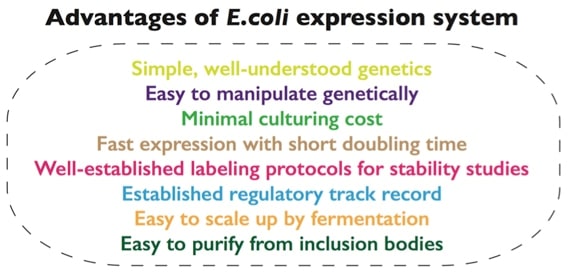Common Protein Expression System ( Part I )

Introduction
In vitro recombinant protein production is a protein obtained by applying recombinant DNA or recombinant RNA technology. Catalog The use of in vitro protein expression technology to extensively produce various types of recombinant proteins, which are used in the fields of medicine, food, daily chemical and other fields. The following briefly introduces the main expression systems of the main recombinant proteins.
Escherichia coli expression system
Escherichia coli has a clear genetic background, low cost, multiple vectors and hosts to choose from. It is not only the most commonly used expression system, but also the most economical protein expression system. The expression system is optimized, such as the compatibility test of the expression vector and the expression strain. , The optimization of induced expression conditions, renaturation, etc., can greatly solve the difficult problems of protein expression and insoluble protein expression. Suitable for proteins that do not require high glycosylation function.
Advantage:
The genetic background is clear; the reproduction is fast, the cost is low, and the anti-pollution ability is strong; the expression is high, the isolation and purification of the expression product is relatively simple, and the stability is good; the types of commercial vectors and strains are very complete, and the scope of application is wide.
Disadvantage:
① It does not have the function of eukaryotic post-transcriptional processing and cannot carry out mRNA splicing, so it can only express cDNA but not eukaryotic genomic genes;
② Without the function of eukaryotic post-translational processing, the protein produced by expression cannot be modified by glycosylation, phosphorylation, etc., and it is difficult to form correct disulfide bond pairing and spatial conformation folding.
③ The expressed protein is often insoluble and will aggregate into inclusion bodies in the bacteria, especially when the amount of expressed target protein exceeds 10% of the total bacterial body protein, inclusion bodies are easily formed. The reasons for the formation of inclusion bodies may be that the protein synthesis is too fast, the polypeptide chains are entangled with each other, and the lack of factors to make the polypeptide chains fold correctly, resulting in the exposure of hydrophobic genes. After bacterial lysis, the centrifugal precipitation of the inclusion bodies is conducive to the preliminary purification of the target protein, but the insoluble protein without biological activity must be renatured to re-spread and refold into a natural protein conformation and good condition. Biologically active protein is often a very difficult task. The vector can also be designed to make E. coli secrete and express the soluble target protein, but the expression level is often not high.
④ Some pyrogenic sources (endotoxins) may be produced, and E. coli itself contains endotoxins and toxic proteins. The purification of the target protein needs to remove endotoxins, which also limits its application.
Medicilon Recombinant Protein Services
Medicilon is a leading provider of comprehensive, high quality recombinant protein and bioprocess services. We offer a variety of recombinant protein expression platforms along with a host of other protein services like chemical protein synthesis, protein refolding and structural biology services.
Multiple Protein Expression Systems
Medicilon researchers established a well-developed multiple protein expression systems and purification services platform, which offers the expression and purification services of a variety of recombinant proteins, with a fast turn-around time and competitive pricing.
- Mammalian Expression System
- Baculovirus Expression System
- Yeast Expression System
- E.coli Protein Expression System
Saccharomyces Cerevisiae Expression System
The use of Saccharomyces cerevisiae to express recombinant proteins began in 1981. Saccharomyces cerevisiae is suitable for expressing scientifically and commercially valuable heterologous proteins. Because it does not produce toxins, combined with its extensive experience in food production, it has become the best host bacteria for the production of pharmaceutical proteins. A series of insulins produced by Saccharomyces cerevisiae, which are widely used in the treatment of diabetes around the world, is one of the important examples of the application of yeast in the field of biotechnology.
Advantage:
High expression level, a good choice for secreted protein or cell expression, low cost, simple culture conditions, strong scalability, post-translational modifications of most eukaryotes, effective protein folding, and no endotoxin.
Disadvantage:
The expression level is lower than that of Pichia pastoris, and the secretion capacity may be lower than that of Pichia pastoris. Glycosylation is different from mammalian cells. The structure of over-glycosylated N-terminal glycosyl chain is sensitizing.
Methanol Yeast Expression System
Methanol yeast is a yeast that can use methanol as the sole carbon source. There are three main types: H. Polymorpha, Candida Bodinii, and Pichia Pastoris. Among them, Pichia Pastoris (Pichia pastoris) is the most widely used gene expression system. Compared with previous gene expression systems, it has unmatched high expression characteristics and has been regarded as one of the most promising tools for protein production.
Advantage:
High expression level, low cost, simple culture, short production cycle, strong scalability, good choice for secreted protein or intracellular expression, efficient protein secretion and simple purification, extensive post-translational modification, N-terminal glycosylation ability Better than Saccharomyces cerevisiae, no endotoxin.
Disadvantage:
Using methanol as an inducer has certain hazards, and glycosylation is still different from mammalian cells.
